Embark on a journey of design inspiration as we explore the captivating world of small front garden ideas gravel. From its aesthetic allure to its functional benefits, gravel offers a versatile canvas to transform your outdoor space into a welcoming haven.
Delve into the diverse types of gravel, each with unique characteristics and advantages. Discover creative ways to incorporate gravel into your design, creating pathways that guide, borders that define, and focal points that enchant.
Gravel Selection
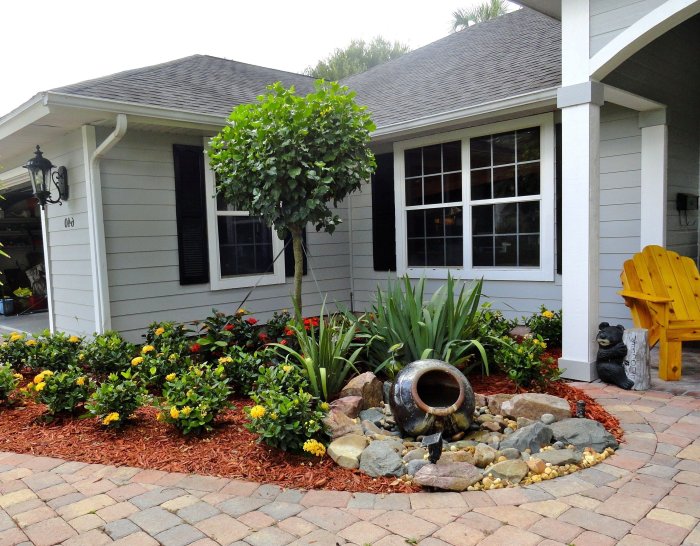
Selecting the right gravel for your small front garden is crucial for both aesthetic appeal and functionality. Here are the different types of gravel to consider, along with their pros and cons:
Pea Gravel
- Small, round stones with a smooth surface
- Pros: Easy to walk on, well-draining, and affordable
- Cons: Can be prone to displacement and may require regular maintenance
Crushed Stone
- Irregularly shaped stones with a rough surface
- Pros: Durable, less prone to displacement, and available in various colors
- Cons: Can be uncomfortable to walk on and may require edging to prevent spreading
Decomposed Granite
- Fine-grained, decomposed granite that compacts over time
- Pros: Natural-looking, well-draining, and suppresses weeds
- Cons: Can be dusty when dry and may require occasional watering to maintain compaction
Tips for Choosing the Right Gravel:
- Consider the size of your garden and the desired look
- Choose gravel that complements the style of your home and landscape
- Determine the intended use (e.g., walking, parking, drainage) and select gravel with appropriate durability
- Consider the color and texture of the gravel to create the desired aesthetic
- Test different gravel samples before making a final decision
Design Considerations
Incorporating gravel into your small front garden design offers a plethora of creative possibilities. Gravel not only adds aesthetic appeal but also enhances functionality, aiding in drainage and reducing maintenance.
When using gravel, consider its texture, color, and size to complement your garden’s overall design. Smaller gravel creates a smoother surface, while larger gravel adds a rustic touch. Choose colors that harmonize with your house’s exterior and existing plants.
Pathways
Gravel pathways are a practical and visually appealing addition to small gardens. They provide a defined path for foot traffic, preventing damage to delicate plants and creating a sense of flow.
Lay a base layer of weed-suppressing fabric before spreading the gravel. Edging the pathway with bricks or stones will keep the gravel in place and enhance its aesthetic appeal.
Borders
Gravel borders create a neat and tidy look, separating different garden areas or defining the edges of flower beds. They also help prevent soil erosion and suppress weeds.
To create a gravel border, dig a shallow trench along the desired edge. Fill the trench with gravel and compact it firmly. Use edging material to secure the border and prevent gravel from spilling over.
Focal Points
Gravel can be used to create eye-catching focal points in your garden. Surround a small tree or statue with gravel to draw attention to it. Or, create a gravel mosaic by arranging different colored gravels in patterns or designs.
When creating focal points, consider the scale and proportion of the elements involved. Use larger gravel for larger features and smaller gravel for more delicate accents.
Drainage and Maintenance
Gravel improves drainage by allowing water to seep through its porous surface. This is especially beneficial in areas prone to waterlogging or heavy rainfall.
Gravel also reduces maintenance by suppressing weed growth and preventing mud from forming after rain. This means less time spent weeding and cleaning up, leaving you more time to enjoy your beautiful garden.
Plant Selection
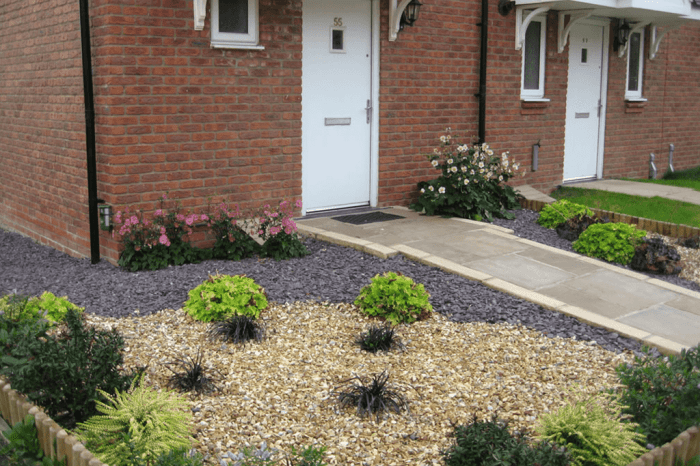
Choosing the right plants is crucial for a successful gravel garden. Plants that thrive in well-drained conditions and tolerate drought are ideal. Consider plants with various sizes, shapes, and textures to create visual interest and balance.
Size and Shape
- Select plants of varying heights and widths to add depth and dimension.
- Tall plants, such as ornamental grasses or upright succulents, can provide a vertical element.
- Groundcovers and trailing plants can fill in gaps and soften the edges.
Texture and Foliage
- Choose plants with contrasting textures, such as fine-leaved thyme, spiky succulents, or broad-leaved hostas.
- Evergreens provide year-round interest, while deciduous plants offer seasonal color changes.
- Consider plants with variegated foliage or unique leaf shapes to add visual appeal.
Arrangement
- Create a balanced arrangement by grouping plants with similar sizes and textures.
- Use focal points, such as a large specimen plant or a contrasting color block, to draw the eye.
- Allow for spacing between plants to prevent overcrowding and ensure proper air circulation.
Edging Options

Edging defines the boundaries of your gravel garden and prevents the gravel from spreading. It also adds a touch of style to your design. There are several different types of edging materials available, each with its own pros and cons.
Concrete Edging
Concrete edging is a durable and long-lasting option. It is available in a variety of shapes and sizes, so you can find the perfect fit for your garden. Concrete edging is also relatively easy to install.
Pros:
- Durable and long-lasting
- Available in a variety of shapes and sizes
- Relatively easy to install
Cons:
- Can be expensive
- Can be difficult to remove if you need to change your design
Brick Edging, Small front garden ideas gravel
Brick edging is another durable and long-lasting option. It is also available in a variety of shapes and sizes, and it can be used to create a variety of different looks. Brick edging is more expensive than concrete edging, but it is also more versatile.
Pros:
- Durable and long-lasting
- Available in a variety of shapes and sizes
- Versatile
Cons:
- More expensive than concrete edging
- Can be difficult to install
Metal Edging
Metal edging is a less expensive option than concrete or brick edging. It is also easier to install, and it can be used to create a variety of different looks. However, metal edging is not as durable as concrete or brick edging, and it can rust over time.
Pros:
- Less expensive than concrete or brick edging
- Easier to install
- Versatile
Cons:
- Not as durable as concrete or brick edging
- Can rust over time
Plastic Edging
Plastic edging is the least expensive option available. It is also easy to install, and it can be used to create a variety of different looks. However, plastic edging is not as durable as concrete, brick, or metal edging, and it can fade over time.
Pros:
- Least expensive option available
- Easy to install
- Versatile
Cons:
- Not as durable as concrete, brick, or metal edging
- Can fade over time
Maintenance Tips
Regular maintenance is crucial for preserving the beauty and functionality of gravel gardens. It prevents weeds, replenishes gravel, and keeps the area clean.
Weed Removal
Weeds can quickly invade gravel gardens, stealing nutrients and water from plants. Regularly remove weeds by hand or use a hoe or weeding tool. Be careful not to disturb the gravel too much.
Gravel Replenishment
Over time, gravel can become compacted or washed away by rain. Replenish gravel as needed to maintain a level surface and prevent weeds from growing.
Cleaning
Keep the gravel area clean by sweeping or hosing it down regularly. Remove debris, such as leaves and twigs, to prevent them from decomposing and becoming a breeding ground for pests.
Preventing Migration and Overgrowth
To prevent gravel from migrating or becoming overgrown, consider installing edging around the garden. Edging materials, such as metal, plastic, or stone, can define the border and prevent plants from spreading beyond the designated area.
Budget Considerations: Small Front Garden Ideas Gravel
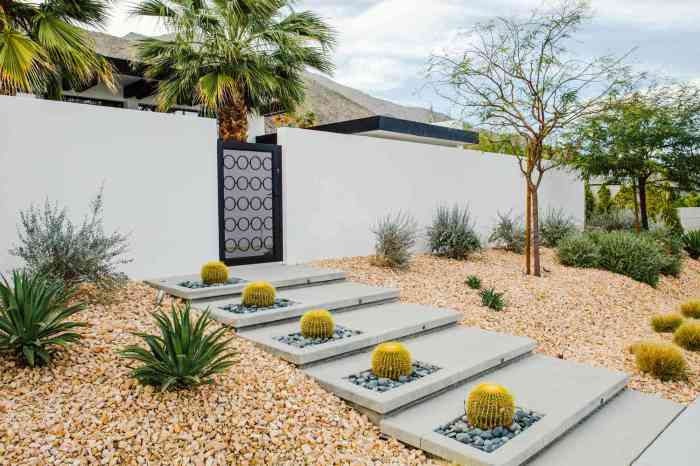
Creating a gravel front garden can be a cost-effective way to enhance your home’s curb appeal. The cost will vary depending on the size of the garden, the type of gravel used, and the complexity of the design. However, as a general rule of thumb, you can expect to pay between $5 and $15 per square foot for materials and labor.Here
are a few tips for saving money on your gravel garden:* Use recycled gravel. Recycled gravel is often available for free or at a very low cost.
- Buy gravel in bulk. Buying gravel in bulk can save you money compared to buying it in smaller bags.
- Do the work yourself. If you’re handy, you can save money by installing the gravel garden yourself.
A well-designed gravel garden can add value to your home. A study by the National Association of Realtors found that homes with well-landscaped yards sell for an average of 5% to 10% more than homes with poorly landscaped yards.
Inspiration Gallery
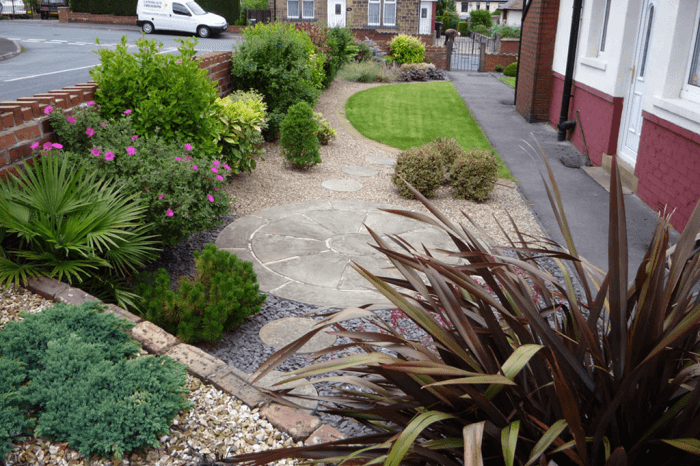
Discover a world of captivating gravel front garden designs that will inspire your own outdoor oasis. From modern minimalist to traditional charm, we present a curated gallery showcasing the versatility and beauty of gravel gardens.
Each design is carefully crafted to highlight unique features, plant combinations, and hardscaping elements. Whether you seek a low-maintenance haven or a vibrant display of color and texture, our inspiration gallery will provide ample ideas to spark your creativity.
Design Showcase
- Modern Minimalist:Clean lines, geometric shapes, and a limited color palette create a sophisticated and elegant front garden. Gravel pathways intersect with raised beds planted with low-growing succulents and ornamental grasses.
- Cottage Charm:A charming gravel path meanders through a cottage garden filled with blooming perennials, climbing roses, and lush foliage. White picket fences and weathered stone accents add a touch of whimsy.
- Mediterranean Retreat:Inspired by the warm hues of the Mediterranean, this gravel garden features terracotta pots, olive trees, and aromatic herbs. A cascading water feature provides a soothing ambiance.
- Japanese Zen:Gravel raked into intricate patterns creates a serene and contemplative space. Carefully placed boulders, bamboo, and Japanese maples evoke a sense of tranquility.
- Tropical Oasis:Vibrant tropical plants, such as banana trees, palms, and ferns, thrive in a gravel garden that mimics their natural habitat. A water feature and bamboo screens create a secluded sanctuary.
DIY Project Guide
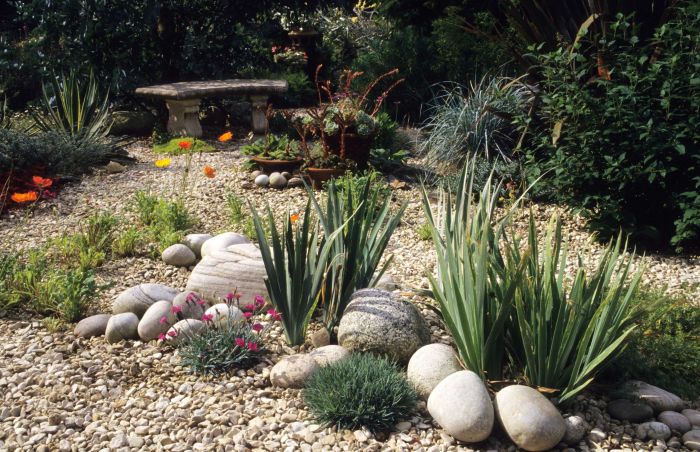
Embark on a journey to create your own charming gravel front garden, a sanctuary of tranquility and beauty that will enhance your home’s curb appeal. Follow these step-by-step instructions to bring your vision to life.
Step 1: Planning and Preparation
Before breaking ground, it’s crucial to plan the layout, select the right gravel, and prepare the site. Determine the size and shape of your garden, choose a gravel that complements your home’s style, and clear the area of any existing vegetation and debris.
Step 2: Laying the Gravel Base
Create a stable foundation by spreading a layer of crushed stone or compacted soil as a base. This base will provide drainage and prevent weeds from sprouting. Ensure the base is level and well-compacted.
Step 3: Installing the Gravel
Spread the chosen gravel over the base, ensuring a thickness of 2-3 inches. Use a rake or screed to level the surface and remove any large stones or debris. Compact the gravel using a hand tamper or plate compactor.
Step 4: Edging and Finishing Touches
Define the perimeter of your garden with edging materials such as bricks, stones, or metal. This will keep the gravel in place and prevent it from spilling onto walkways or lawns. Add decorative elements like boulders, stepping stones, or plants to enhance the aesthetic appeal.
Troubleshooting Common Problems
-
-*Weeds growing through the gravel
Install a weed barrier beneath the gravel base to prevent weeds from sprouting.
-*Gravel shifting or washing away
Use larger gravel sizes or a thicker base layer to prevent movement. Consider adding a border to contain the gravel.
-*Water pooling in the garden
Ensure proper drainage by sloping the base or adding a French drain to channel excess water away from the garden.
Additional Considerations
Environmental factors play a crucial role in the design of a gravel front garden. Consider local climate, soil conditions, and available sunlight.Gravel provides excellent water conservation benefits by reducing evaporation and promoting rainwater infiltration. Its thermal mass also aids in heat retention, mitigating temperature fluctuations.
Sustainable Practices
Incorporate sustainable practices by using recycled or locally sourced gravel. Consider planting native or drought-tolerant plants that require minimal watering. Implement rainwater harvesting systems to collect and store rainwater for irrigation.
Wrap-Up
Unleash the potential of your small front garden with the versatility of gravel. Embrace its beauty, practicality, and affordability, and create an outdoor oasis that reflects your personal style. Let gravel be your muse as you design a space that invites, inspires, and brings joy to your doorstep.
FAQ Compilation
What are the advantages of using gravel in small front gardens?
Gravel offers excellent drainage, reducing waterlogging and creating a low-maintenance surface. Its versatility allows for creative designs, and it can enhance the visual appeal of plants and hardscaping.
How do I choose the right gravel for my front garden?
Consider factors such as color, size, texture, and durability. Pea gravel is a popular choice for its small size and rounded shape, while larger gravel can create a more dramatic effect. Choose a gravel that complements your garden’s style and meets your functional needs.
Can I grow plants in a gravel garden?
Yes, there are many plants that thrive in well-drained gravel gardens. Drought-tolerant plants, such as succulents, sedums, and ornamental grasses, are excellent choices. Consider plants with contrasting textures and colors to create visual interest.


